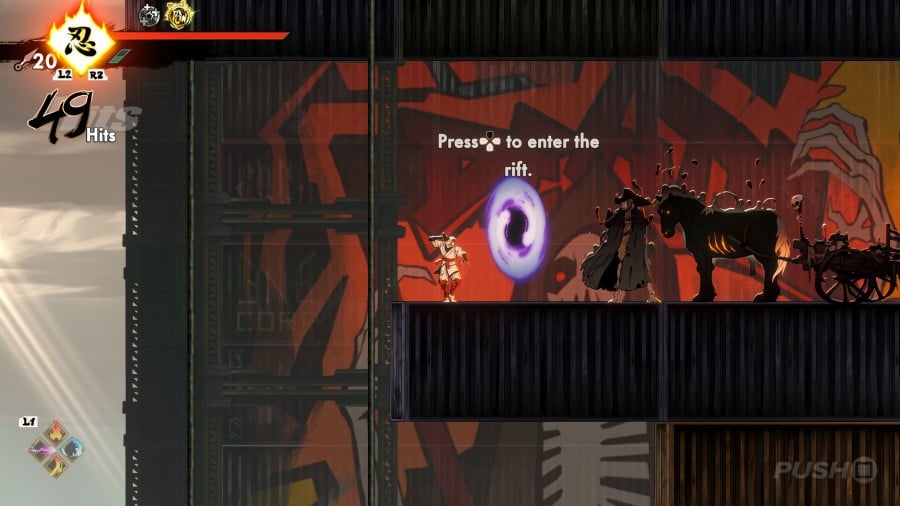
SEGA’s fan favourite Shinobi series is one that casts a long shadow, dating all the way back to the late eighties. Despite several beloved entries in the franchise, it’s been sitting dormant since 2011, but that’s all changed with the arrival of Shinobi: Art of Vengeance.
This brand new game, from the studio behind Streets of Rage 4 and Wonder Boy: The Dragon’s Trap, is a bold reinvention that honours its predecessors while confidently setting out its own stall. The result is a fresh action platformer that’s probably the best the series has ever been.
The legendary Oboro clan leader, Joe Musashi, is living a peaceful life when a new threat, Lord Ruse and his E.N.E. Corp forces, descend upon the village, aiming to wipe out the last remaining threat to their global domination.
With most of his clan turned to stone, Joe must avenge them by taking down E.N.E. Corp bit by bit, joining forces with some unexpected allies along the way.

It’s not the most complex tale ever told, but it’s a fine framework for a side-scrolling action game, taking you to a wide range of locations across a dozen or so stages.
Levels are large — feeling perhaps a little too long at times — with multiple pathways to explore. While this isn’t a Metroidvania, the stage maps certainly make it look like one, with different coloured rooms indicating optional areas and boss arenas.
Stages are not only big, they’re varied; from the gorgeous Oboro village, you’ll explore a vibrant lantern festival, a neon-lit cityscape, a mysterious sub-nautical base, and plenty more.
Each area is rendered in beautiful detail thanks to a lovely illustrated art style. Some details can look a little fuzzy when cutscene cameras zoom in, but by and large this is a very handsome game, backed up by some lovely animation on Joe and enemy characters.

Perhaps best of all, though, is that Art of Vengeance plays as good as it looks. The combat in particular is a joy, thanks to moves that feel very easy to combo into one another.
You have light and heavy attacks, which can be combined in various different ways, and this only grows more versatile as you unlock more moves. By the end of the game, you’ll be able to juggle enemies for their entire life bar, both with assaults from the ground or in mid-air.
Perhaps key to what makes the combat feel so fluid and satisfying is the ability to cancel attacks into a dash, which then allows you to begin a new combo and keep your offence going. It feels fantastic.
Heavy attacks and throwable kunai are your best tools to build up an opponent’s Execution Gauge. Once full, a symbol above their head indicates they can be eliminated with an insta-kill Shinobi Execution. The trick here is that, the more enemies you kill in this manner simultaneously, the more rewards you’ll get in return — coins, kunai, and health.

It’s a great mechanic because, not only is it very satisfying to pull off, it presents you with a choice. Do you kill foes the normal way, which may be faster and will get certain baddies out of your hair, or do you focus on performing Executions, which will leave more enemies onscreen while you fill their meters?
It adds a touch of strategic thinking to what is otherwise a pretty hack-and-slash combat system — albeit one that’s super fun thanks to the wide range of manoeuvres you gain access to over the course of the game.
The only thing we’d say is that enemies ready for Execution who happen to be offscreen sometimes won’t be included; the rule about this feels inconsistent in our experience.
On top of all that are Ninpo and Ninjutsu abilities. The former is a series of magical moves, like a blast of fire, or a water shield you can use to counter incoming blows. The latter are more powerful abilities you can only use when your rage meter is full, ranging from a fiery attack that damages every enemy onscreen to a heal that instantly replenishes a huge portion of your health.

You can also equip a pair of amulets — one passive and one combo. The passive amulet’s effects occur, well, passively, while your combo amulet will only become active once you reach a specific number of consecutive hits without being hit yourself.
You’ll unlock plenty of both amulet types, and they have some significant effects that change the way you play, prioritising particular Ninpo, or helping to build the rage meter faster, for example.
Putting everything together results in a combat system we just wanted to toy with endlessly, never once growing weary of the action across the game’s 15-ish hours.
Platforming is a tad less impressive, mainly due to some iffy collision on certain walls and hazards, but it’s broadly very responsive. Again, you’ll gain more abilities as the game goes on, such as a grapple hook and a glider.

These items make the platforming sequences more complex as you go, and also allow you to explore previously inaccessible areas in past stages.
Exploring levels fully is well worth it, as you’ll find lots of useful items, like Oboro Relics — needed to unlock more items in the shop — and Rifts, which teleport you to particularly tough challenges. Beating all of these nets you a nice reward, too.
When you finish the story, the game gives you more reasons to stick around. Arcade mode shows your score and time as you play each level, and you get a letter grade at the end depending on how you did.
The length of the stages is felt more here; they’re not exactly designed for speedy run-throughs. Still, Arcade mode is a welcome addition that score-chasers will enjoy.

Boss Rush mode is exactly what it sounds like — you fight every boss in the game back-to-back, seeing how far you can get with one life. It’s nothing earth-shattering, but it’s always a good final challenge for those looking to push their skills.
Source link


